Allegro
Coming of age with the Queens Symphony Orchestra
Volume 117, No. 7July, 2017
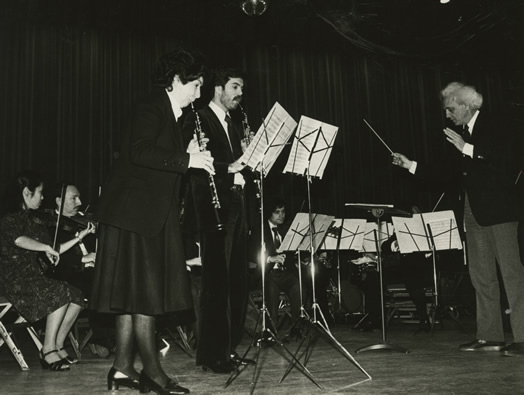
The Queens Symphony Orchestra was founded by David Katz, shown above conducting. Also in the picture, which was taken in 1986 or 1987, are Local 802 members Marsha Heller and Matt Sullivan, who both still play oboe in the QSO today, with Marsha as principal.
All photos below by Walter Karling.
What makes a young musician decide to pursue her love for the art form as a profession? For each of us the impetus is different, but often some formative experience starts the journey. For me, there were two such experiences. One was participating in six performances of “The Saint of Bleeker Street” with the legendary New York conductor Vincent La Selva in the early 1960s. The other was joining the Queens Symphony Orchestra.
The first thing I remember about the QSO is waiting on a dark street corner in downtown Flushing for a ride to my first rehearsal with the group. The conductor and founder of the orchestra, David Katz, had agreed to pick me up. (I was a non-driver – and a high school student – at the time.) For the founder and director, this was just one of the many non-musical tasks that goes into putting together an amateur orchestra. Although it has been over 60 years since that evening rehearsal in 1956, I still vividly remember the pieces we rehearsed. They were Gluck’s overture to “Iphigénie en Aulide” as arranged by Wagner, and Beethoven’s “Prometheus” overture.
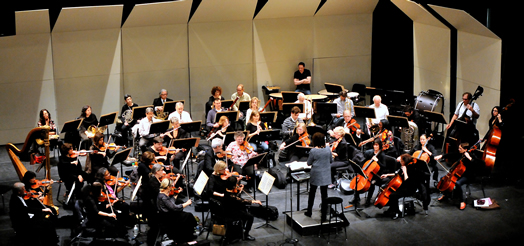
The QSO rehearsing earlier this year, with Maureen Hynes conducting.
Playing in this orchestra was a revelation. As a student at Bayside High School, whose music department was known to be especially good, I had a decent school orchestra to play in, but this orchestra was another creature altogether. All the music played was “real.” No school arrangements with all musical lines doubled were used here. There was the entire orchestral literature to explore and learn, and many of the players played at a professional level. Concerts and rehearsals took place at Forest Hills High School. David Katz, tall, slim and elegant, led us through rehearsals with enthusiasm and vigor. One of his favorite verbal commands was, “ups and downs, ups and downs!” It was at least a year before I was able to figure out what he meant by that. He was referring to the small crescendos and diminuendos that are not written in the music but are used instinctively in shaping musical phrases.
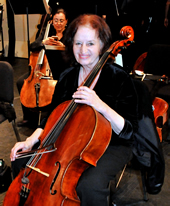
Amy Camus
Throughout the years we covered a lot of standard repertoire by Beethoven, Schumann, Schubert, Mozart and Brahms and some modern repertoire as well. But notes and rhythms were not the only thing I learned. One of the pleasures of playing with any ensemble is the social aspect, and I couldn’t fail to notice the three handsome young trombone players in the back of the orchestra. There is no better activity to indulge in than watching eye candy during long rests and longer breaks, but those trombone boys were not always at rehearsals. With a little research I discovered that if the repertoire was Beethoven’s fifth symphony (last movement only) or later, the rehearsals became a lot more interesting. (Beethoven doesn’t use trombones in his first four symphonies.) It was one of many interesting facts about music history that still fascinates. I also discovered that learning anything is much more immediately accomplished if you can somehow relate it to romance.
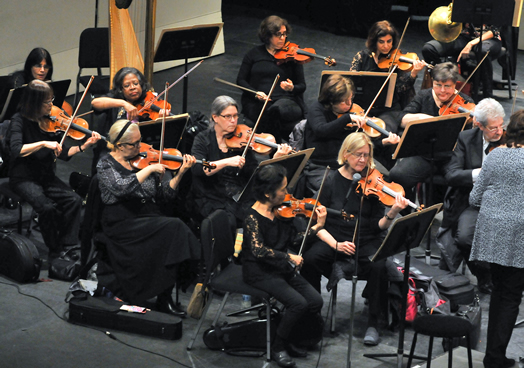
The QSO rehearsing earlier this year, with Maureen Hynes conducting.
In those days, female brass players were rare. In fact, professional orchestras consisted solely of men, with the possible exception of harpists. I still have a copy of an article from Life Magazine in 1957 entitled “It takes 100 Men to Make an Orchestra.” Today, this title shocks, but then it was the reality. There was the occasional “women’s orchestra,” but it was not until 1966 that the New York Philharmonic finally admitted its first female member, bassist Orin O’Brien, who still plays with the Philharmonic today. Of course, an amateur orchestra accepts all volunteers gladly and by the time the Queens Symphony became professional, women were a normally accepted sight in professional orchestras. In 1977, David Katz decided to make the orchestra professional and current members had to audition. Many members dropped out but there were some up-and-coming young professionals who did audition. My audition took place in the conductor’s office, as did most professional auditions at the time. Today’s process – with prospective musicians chosen through recorded pre-audition submissions and auditions held behind a screen with a committee adjudicating and choosing a handful of finalists out of several hundred applicants – was all far in the future. My audition went right for the jugular with excerpts from “Don Juan,” and my nervousness was exacerbated by the office chaos that suddenly ensued just as I was about to start playing. There were back-to-back phone calls and people walking in and out. David told me to start, and start I did, a half step higher than written. Fortunately for me, with all David’s musical talents, the dubious one of perfect pitch was not among them. I was in! When I told the parents of one of my students (who were QSO subscribers) that the orchestra was turning professional, which also meant a rise in ticket prices, the mom said, “So what have we been hearing up until now?” I would be willing to bet that 80 percent of the audience did not notice the change in performance quality.
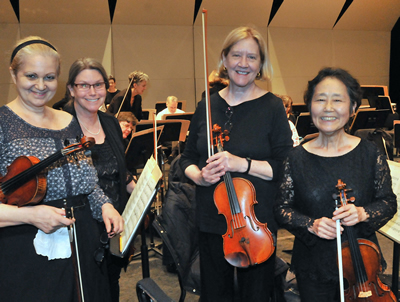
Natalie Kriegler, Laura Mole, Nancy Reed and concertmaster Masako Yanagita.
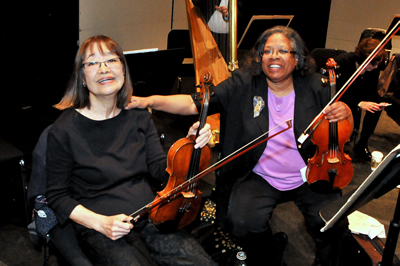
Katsuko Esaki and Sandra Billingslea
As a newly professional ensemble, the QSO changed its concert venue from Forest Hills High School to the recently-built Colden Center at Queens College. We filled the 2,143-seat hall to capacity with each concert. Even if, as I suspect it was, the intermission was the highlight for many subscribers, they were still there supporting great music. For a number of years in the 1980s, concerts for chamber orchestra were an especially joyful part of the QSO offerings. These were held in the Queens Theater in Flushing Meadows. I still remember risking life and limb driving through the night from a three-week gig in New Hampshire to be on time for a chamber orchestra rehearsal at 10 a.m. The chamber concerts were a chance to perform the Brandenburg concerti and other works for a small ensemble. Performing Mendelssohn’s wonderful octet (which the composer wrote when he was 16) was the closest thing to pure ecstasy that I have ever experienced.
Being part of a professional orchestra meant more than being paid for your services. It was a chance to learn repertoire like Stravinsky’s “Firebird,” which I chiefly remember as having more flats than I had ever seen in a piece of music up to that point, and Debussy’s “La Mer,” works that separate the pros from the amateurs. We also played some music that was hot off the press. Those were the early days of trying to include a newly-composed modern work for the edification of the audience in every program, whether or not they would appreciate it. American audiences generally were, and are, very polite, and we all knew that modern music for them was something to be endured, but not necessarily enjoyed. (It should be mentioned that “modern music” would include early 20th century master composers like Ravel, Prokofiev and the like.) The QSO audience listened to modern works with good grace. On one occasion, there was a QSO program that included not one, but two modern works, one of which included portions of aleatoric or “chance” music, which was having a brief revival at the time. We all knew that this was not what our audience had signed up for. At the end of the first modern work, there was polite, unenthusiastic applause. After the second one, there were actual boos!
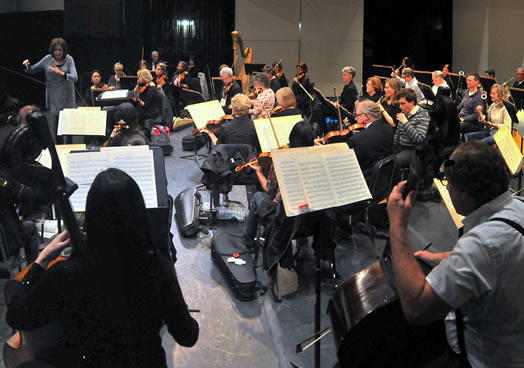
The QSO rehearsing earlier this year, with Maureen Hynes conducting.
We had great soloists, among them Pincus Zuckerman, Michael Rabin, Itzhak Perlman, Roberta Peters and Janos Starker. Aaron Rosand, a fine violinist with a very respectable solo career was reputed to have said, “I’ve been called the greatest violinist in the world…but not in New York.” He had the misfortune to play with the QSO when the freelance orchestras in New York were on the verge of going on strike, which made for a very uncomfortable situation for all concerned. Another memorable soloist for me was Sharon Robinson, who is as beautiful and glamorous as she is musically gifted. She wore a dress that was a concoction of pastel-colored tulle and a long silk scarf of the same color. The cello was framed by yards of fabric and with a dramatic sweep of one arm, she flung the scarf and her long blond hair over her shoulder and tore into the Saint-Saëns cello concerto. There was a real danger of the prelude upstaging the actual performance.
Our original concertmaster and principal cellist had decamped for a retirement home out west, and Masako Yanagita became concertmaster, a position she still holds today. Her husband, Abba Bogin, became the contractor and Daniel Vandersall joined as principal cellist. I had the good fortune to have Danny as stand partner and mentor. He was a large man with a great appreciation of beauty, whether in women, art or instruments. He was well traveled, going to Italy frequently to search for violins and cellos, and a collector of beautiful objects of all kinds. His wife, Assunta dell’Aquilla, a harpist, was a wonderful character, highly cultured while totally down to earth, joyfully irreverent and full of energy. It was thanks to Danny, and by extension, the QSO, that I got the cello of my dreams.
Any string player (and possibly any musician) knows that choosing an instrument is exactly like choosing a spouse. Each individual instrument has its own unique voice and personality, can be cooperative and easygoing and then suddenly turn recalcitrant and stubborn. At one point, my cello was undergoing some repair and I needed something to play on. Danny, who was the soul of kindness and generosity, agreed to lend me his “second best cello,” and I fell instantly in love. In the early 70s the price of fine string instruments had not gone completely through the roof as in today’s market, but neither were they highly affordable. My mother, a widow and child of the Depression who would travel several miles out of her way to save seven cents on a can of tomato sauce, felt that this was the thing that she had been scrimping and saving for all her life, and I became the proud owner of my soul mate, instrumentally speaking.
When David Katz died, far too young, in 1987, it was a blow to all of us. A small group of instrumentalists from the orchestra played at his funeral. (It’s worth mentioning that David’s daughter Melinda has also contributed to the culture and development of Queens: she was a member of City Council and is now the Queens Borough President!)
In the years since then, there have been only three other conductors: Arthur Fagan, Constantine Kitsopoulos and now Martin Majkut. (Maureen Hynes, pictured on these pages, conducted five concerts over the past year as one of four finalists for the music director position. She hopes that her conducting relationship with the orchestra will continue in the future.)
Abba Bogin was our beloved contractor. As a student, I had heard about contractors in rather unflattering terms, caught as they are between players and management. Before Local 802 came up with first-call lists and tenure, contractors had absolute authority over whether you would be called for a gig or replaced by the “player of the week.” But Abba was the most supportive, loyal and helpful person imaginable, as have been the contractors who have succeeded him. (Abba died in 2011 at the age of 85.)
Miraculously, the Queens Symphony continues on, although in a very different and much more difficult climate than in its early years. We, the members of the orchestra, are growing older together. Going to a rehearsal is very much like going to a reunion with friends of many years standing. Many of us have been with the orchestra since the 1970s and 80s. We’re older but I think we can honestly say that we’ve never been better or enjoyed music making more. It’s a reminder of two ways of thinking about being a musician. One is the idea that music is not a profession, it’s a calling. The other is the saying attributed to Rachmaninoff: “Music is enough for lifetime, but a lifetime is not enough for music.”
Cellist Amy Camus, a member of Local 802 since 1961, has been a member of the QSO since 1956.
